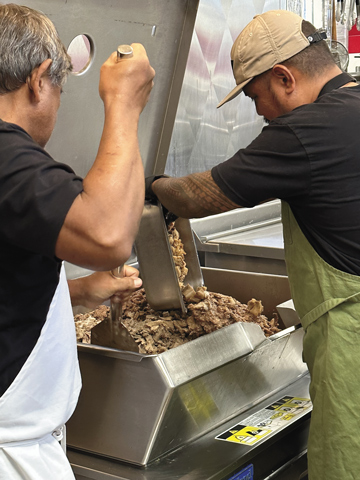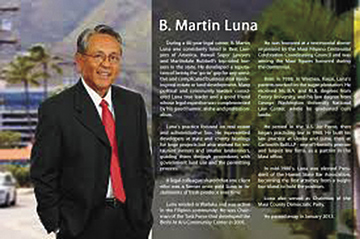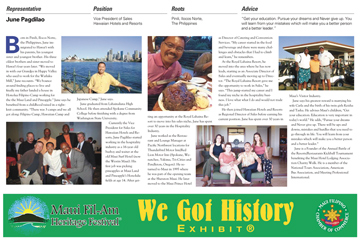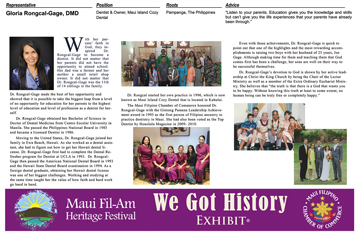
October is National Filipino American History Month
Gilbert S.C. Keith-Agaran
From 2011 through 2019, the Maui Filipino Chamber of Commerce Foundation sponsored the Maui Fil-Am Heritage Festival as part of the commemoration. The festival, held initially at Maui Mall and then moving to the Queen Ka‘ahumanu Center included some signature events like the Master P-Noy Chef cook off. A crowd-pleasing display of local culinary mastery, in the course of the decade, the Master P-Noy Chef cook off featured many of Maui’s Filipino best chefs including Sheldon Simeon (2011), Joey Macadangdang (2012–14), Ritchard Cariaga (2015), Gemsley Balagso (2016), Isaac Bancaco, Rey Baisa, Jonathan Pasion (2017–2018), Kirk Areola and Dennis Yu-Cua. Abby Ferrer won the final title in 2019, besting former winners Macadangdang and Balagso.


Photo: Gil Keith-Agaran
While the community continues to raise the Philippine flag at the County Building to mark the start of the October commemoration, the festival itself, like the Maui County Fair, went on hiatus during the pandemic. One festival feature lost was We Got History displaying Filipino contributions to the Maui community. From entrepreneurs like Lawrence Cabanilla, who owned Cabanilla Lahaina Shell and Cabanilla Body & Fender, to Filipino medical pioneers like Jose Ligot Romero, Hilario Aquilizan, Marconi Dioso and Jose Chu-Chiaco, to Filipino managers such as Chris Rabang, Glen Casil and Fred Torres at major properties at Maui’s resorts, the history portion chronicled and celebrated Filipino involvement in our island’s life.
I was a History major in college (I had to find some professor to sign off on my concentration in American Intellectual History—literature, arts and film, music, philosophy and politics—not everyone in the academy believe there was anything unique about American society). I am conscious history is written after the history making. I expect to have more time to catch up on all the books I have been meaning to read.

File image: Maui Fil-Am Heritage Festival
While Maka walked me at Central Maui Regional Sports Complex the other day, I thought about how time shifts perspectives. As she took me on a brisk stroll up and down the sloping banks above and along the playing fields, I enjoyed the sounds of people in the 65-acre park. Pop Warner football practiced on one field, pee wee girls softball trained on one of the diamonds, little leaguers played catch and field grounders on another, and a girls team ran on the soccer fields. And walkers like me led by our dogs through all the activity. It is well used.
Additional fields would be well used as well.

File image: Maui Fil-Am Heritage Festival
Yet when then-Senator Shan Tsutsui proposed developing the new park like the Waipi‘o complex on O‘ahu, residents in the subdivision adjoining the 65-acres expressed alarm. They thought a recreational center would reduce property values. The park would attract rowdy drunk users. The location at the end of Kamehameha across from Pōmaika‘i School would increase traffic. The County would never maintain all the new fields.
The Maui delegation—mainly Tsutsui and Kyle Yamashita—listened but nevertheless moved the project forward, adding a fence to separate the park from the nearby neighborhoods. They also heard from the many youth coaches and parents and wanted to provide more sports access for Maui’s children.

File image: Maui Fil-Am Heritage Festival
Today the complex is an asset for Central Maui and the nearby residents.
The Mayor recently named a number of people to his Lahaina Advisory Team which will help guide his administration’s fire recovery decisions. The folks serving should keep in mind that the Lahaina lost was a community of multi-generational families and clans. Many Lahaina neighborhoods came out of the rural and agricultural plantation era, with homes and additions and ‘ohanas constructed before formal zoning limitations, and modern urban building standards. As might be expected given the costs of housing and acceptable and expected cultural norms, many homes included multi-generational families.

File image: Maui Fil-Am Heritage Festival
A lot of questions remain. Will the County facilitate re-building residences allowing close knit clans to stay together? Will permit processing take so long displaced residents are compelled to sell and move? Will redevelopment guidelines effectively price out local residents from even attempting to remain on their family lands? And will policy makers take the time to pay attention to folks who do not speak up or who do not trust the process or decision makers or who do not have articulate and recognized advocates for their views and concerns?

File image: Maui Fil-Am Heritage Festival
Maui is at the beginning of deciding how Lahaina is rebuilt. There are a lot of different visions. I hope the powers that be take time to find out what the less vocal residents would also like to see, especially on the lands they always intended to leave as their legacy to their children and grandchildren.
 Gilbert S.C. Keith-Agaran ends his time as the State Senator for Central Maui on October 31, 2023. He served as the State Representative from Kahului from 2009–2012 before moving to the upper chamber in 2013. He practices law in Wailuku with Takitani Agaran Jorgensen & Wildman, LLLP. His law firm is representing Maui residents and businesses with claims arising from the Lahaina fire.
Gilbert S.C. Keith-Agaran ends his time as the State Senator for Central Maui on October 31, 2023. He served as the State Representative from Kahului from 2009–2012 before moving to the upper chamber in 2013. He practices law in Wailuku with Takitani Agaran Jorgensen & Wildman, LLLP. His law firm is representing Maui residents and businesses with claims arising from the Lahaina fire.
